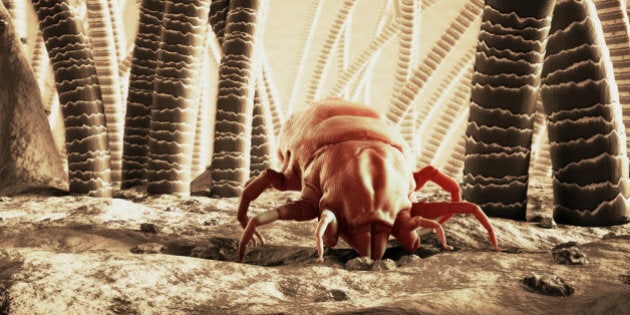
It's that time of the year when the air warms up, the humidity rises, and those with allergies suffer. The culprits are numerous but usually involve outdoors allergens. Yet, one particularly problematic pest lives inside the home and is known to cause a variety of respiratory troubles including asthma.
It's the lowly dust mite.
Dust mites have been known to be a problem in Canada for well over four decades. They generally peak in and around the summer months as they prefer warm and humid environments. The insects are known to produce several protein allergens, which they release in their feces and eventually end up in the air. When the mite population grows high enough, the concentration of these allergens can initiate a reaction.
The stimulation doesn't end there. Mites also produce a chemical essential for its survival. It's called chitin and it is a long-chain of sugars similar to fibre. For the insect, this molecule helps to maintain its structural integrity. However, it is also very good at triggering a stronger immune response turning what might be a gentle reaction into a full blown storm. For this reason, a variation of chitin known as chitosan has been eyed as a possible addition to vaccines to improve their desired effect.
The apparent double-edged sword of chitin has been somewhat of a mystery. The site of exposure is the most important factor. If chitin is introduced under the skin or in the gastrointestinal tract, there is a good, healthy immune response. If exposure happens in the respiratory tract, the reaction may be worrisome. How this happens, however, has not been given much attention until recently.
The latest piece of the puzzle came earlier this year when a Korean group of researchers examined the molecular interaction of chitin and the immune response. Using mice, they attempted to observe the mechanism of allergy amplification caused by chitin. Their results offer perspective on what is occurring in the lungs and also may open the door to future therapies and prevention medication.
The team first examined the effects of various components of chitin. They collected dust mites so they could isolate the molecule. Once they had done this, the broke it down further to smaller components. They hoped to find one particular piece within chitin responsible for causing allergic reactions.
As expected, the whole chitin molecule caused the allergic reaction in the animals. But when the chemical was broken down, there were no specific pieces capable of causing trouble. In order for the immune system to react, the entire molecule had to be present.
With this in hand, the group went back to the whole chitin and closely examined the immune response upon exposure. They expected the allergy pathway to be stimulated while all other immune branches would be unresponsive. When the concentration of chitin was low (less than 0.1 milligrams), there was no response from the other immune functions. However, when the concentration went higher -- equivalent to an infested home -- the immune system went haywire.
Within three hours, the cascade began with the infiltration of several immune chemicals known to be involved in fighting infections. By six hours, the allergy arm of the immune system was activated. By 12 hours, the lungs were suffering from a storm of immune inflammation. Within a half day, the lungs had become a battle zone. For the mice, the situation meant symptoms and the risk for other complications.
The results of the study offer some perspective on how dust mites can affect our health. When their concentration is low, we generally won't suffer. When they grow in number the risk increases particularly for those who suffer from allergies. If the situation turns into infestation, then the likelihood for continual problems is apparent.
As for figuring out how to control the problem, the study offers one suggestion: break up the chitin. When the molecule is broken down, we are safe. This discovery may lead to novel therapies and treatments for sufferers as well as chitin-breaking cleaning products.
In the meantime, the study shows the best way to stay safe is to reduce the number of dust mites in the home. This can be attained through less mite-friendly furnishings in the home, keeping the humidity below 50 per cent, and ensuring to clean on a more regular basis. Another option is steam. Dust mites are sensitive to high heat and studies have shown the technique may be able to reduce the number and possibly eradicate them from a home.
Follow HuffPost Canada Blogs on Facebook
ALSO ON HUFFPOST:
